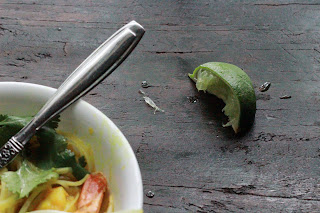Sometimes I just want a really good bowl of soup.
Laksa is a Malaysian soup that fits the bill today- it's spicy, sweet and savory (plus, it's got a sunny yellow hue thanks to turmeric).
And you don't have to go to a restaurant for it.
It's a flavorful broth, filled out with coconut milk and poured over rice noodles with garnishes to add textures and flavors.
There's a slight funk with the shrimp paste and fish sauce, but it's still fresh due to the green onion and cilantro. So much all in one bowl.
Other options/additions:
pumpkin
tofu
green beans
mushrooms
rice instead of rice noodles
red pepper or chile as a garnish
sliced cucumber as a garnish
fresh mint leaves
Shrimp Laksa
Adapted from a Gary Mehigan recipe
serves 4-6
1 lb. (450 g) raw shrimp, shells on
2 inch piece of fresh ginger, peeled and roughly chopped
1 stalk lemongrass, outer leaves removed and tender inner white part chopped
4 shallots, peeled and roughly chopped
4 cloves garlic, peeled and crushed
1 jalapeno chile, stemmed, seeded, and roughly chopped
cilantro (coriander) stems (1/2 the bunch if large, all if it's smaller)- reserve the leaves
2 t (20 g) shrimp paste
3 T (45 ml) peanut or coconut oil
2 t (5 g) ground turmeric
13 oz (400 ml) coconut milk
4 c (950 ml) vegetable stock
3 T (45 ml) fish sauce
1 T (17 g) brown sugar or palm sugar
kaffir lime leaves (optional)
To serve:
5-7 oz (150-200 g) rice noodles
sliced green onions
cilantro leaves
bean sprouts
lime wedges
chili sauce on the side if anyone is so inclined
Peel and devein the shrimp, leaving the tails intact. Set the shells and shrimp aside in separate bowls.
To make the laksa paste:
In the bowl of a food processor (or with a large mortar and pestle), puree (or pound) the ginger and lemongrass. Add the shallots and continue to work the mixture so it forms a paste, scraping down the sides of the food processor or redistributing the contents of the mortar as necessary. Add the garlic, jalapeno, and cilantro stems and continue the process. Add the shrimp paste and work it through the laksa paste until everything is well-combined.
Set the mixture aside.
Heat the peanut or coconut oil in a large saucepan over medium heat. Add the reserved shrimp shells and saute about a minute or until they turn pink. Add the laksa paste and ground turmeric and saute, stirring often, about 5 minutes. Pour in the coconut milk and reduce the heat to low. Stir the mixture and scrape the bottom of the pot to release any of the paste that might have adhered. Continue cooking the coconut milk mixture about 5 minutes, stirring occasionally.
Add the vegetable stock, fish sauce, brown sugar, and several kaffir lime leaves (if using). Increase the heat back to medium and bring the mixture to a boil. Reduce the heat to low and simmer the soup 20 minutes, stirring occasionally.
With a large slotted spoon, strainer, or spider, remove the shrimp shells and lime leaves.
Add the raw shrimp and cook on low 2-3 minutes, until the shrimp are pink and cooked through.
Meanwhile prepare the rice noodles per package instructions (usually soaking in hot water a few minutes). Divide the noodles between bowls and pour the hot laksa broth over the top. Add bean sprouts, cilantro leaves, and sliced green onions. Top with a few shrimp and serve with lime wedges and chili sauce.










































